The world of kayaking is as wild as you choose to make it. My kayak adventures have taken me from Lake Superior to the Aleutian islands. From the coast of Wales to the Golden Isles of Georgia. Hot weather, cold weather, even a little snow from time to time. The key to staying safe and comfortable on the water is choosing clothes that protect against the elements—sun, wind, rain, heat and cold.
The good news is that you may already have some of the right clothes in your closet. Kayaking clothing shares similarities with other outdoor gear. You’ll need insulating layers for cold, sun protection in heat and waterproof shells for rain. Throw in a little specialized clothing for cold water protection, and you’ll be well on your way to kayaking comfortably.
What to wear kayaking
We’ll go into more detail later in this article, but for starters, here are the key points to remember when choosing what to wear to go kayaking:
- Always wear your life jacket. Technically, we call these vests personal flotation devices or PFDs. Even if you’re a strong swimmer, it’s a good idea to wear your PFD anytime you’re on the water kayaking. PFDs make it easier to swim, easier to get back into your kayak in a rescue and even provide some insulation.
- Dress for immersion. Cold water is a killer. Water conducts heat away from the body 25 times faster than air, so even cool water can chill you quickly. That’s why it’s important to dress for a swim even if you don’t plan to tip. Specialized kayaking clothing like wet suits and dry suits are key for cold water safety. More on this below.
- Layer up. Dressing in layers is the best way to stay comfortable in the outdoors and kayaking is no exception. Savvy paddlers wear a wicking base layer next to their skin to manage moisture, insulating layers over that for warmth, and a shell layer on top to block wind when needed. It’s always a good idea to pack an extra layer in a dry bag, just in case you get chilled.
- Don’t get burned. Sunlight reflecting off the water is intense and it doesn’t take long to get scorched, even with cloud cover. A base layer with long sleeves provides good coverage and sun protection. Wear sunglasses and a wide-brimmed hat, and apply sunscreen as needed.
- Avoid cotton. Cotton absorbs moisture and stays damp. Wicking, fast-drying materials, like nylon and polyester, are better options to keep from getting chilled on the water. While wool takes longer to dry, it still provides insulation when wet, making it a good alternative.
When to wear a wetsuit or drysuit
The U.S. Coast Guard considers any water below 59°F (15°C) dangerous. Water this cold is painful against bare skin, can cause cold water shock and will rapidly chill your body into hypothermia. Over time, hypothermia can cause you to lose muscle control and may lead to drowning.
What if the water is warmer than 59°F? The fact is even 70°F water will give you a chill. Remember that water conducts your body heat away 25 times faster than air. Seventy-degree air is a pleasant temperature for a summer hike, but it will make your teeth rattle after an hour of swimming. When kayaking, dress for immersion any time water temperatures are 70°F or below.
What about air temperatures? For years, kayakers were advised to dress for immersion whenever the air and water temperature added up to less than 120°F. The problem is that sometimes the water can be dangerously cold even on a scorching hot day. This is common on Lake Superior, where summertime water temperatures might be in the 50’s while air temps soar into the 80’s. Nowadays, the National Center for Cold Water Safety recommends using water temperature alone as a guideline.
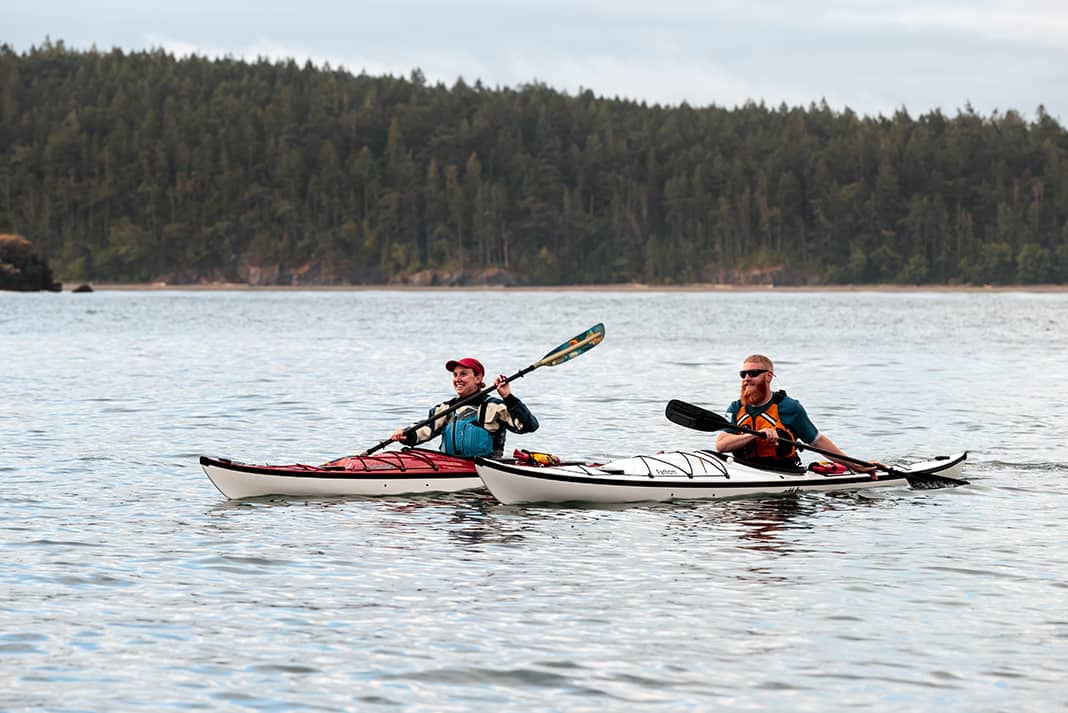
Wetsuit vs. drysuit: Which should you wear?
Now that we know when to dress for immersion, we can talk about what to wear to stay warm in the water. There are two ways to go: wet and dry.
Wetsuits have been around for more than 70 years and are the most common approach. These specialized insulating layers hold water close to the skin where it’s warmed by body heat. Wetsuits keep you much warmer in the water than conventional outdoor clothing. They are also an affordable choice.
Unfortunately, wetsuits don’t perform well at the extremes. When temperatures are very cold, wet systems leave paddlers chilled. When air temperatures are very hot, it’s hard to stay cool in a wetsuit unless you jump in the water. Drysuits are better in these situations.
Drysuits keep you warmer because the suit is sealed to keep water away from your body. Insulation worn under a drysuit stays (mostly) dry, so water can’t conduct heat away from your body as fast. Insulating layers under a drysuit can be varied to adjust for different water and air temperatures, so you’re less likely to overheat in the summer or get chilled on a cold spring day. Unfortunately, drysuits are more expensive, particularly those with breathable fabrics that offer the broadest comfort range. Drysuits come in men’s, women’s and unisex models.
Layering basics: How to stay warm and dry
Here’s a quick primer on layering for comfort on the water.
Base layers are essential for managing moisture during kayaking. They wick perspiration by moving it from the inside to the outside of the fabric. Polyester is the most common material due to its quick-drying properties, while merino wool offers warmth, effective wicking and odor resistance. Nylon, though slow to dry, is sometimes used for sun protection. Kayak-specific base layers are designed with features like chafe-reducing seams, higher waistbands and longer hems for comfort while paddling.
Insulating layers for kayaking comes in two types: wet and dry. Wetsuits keep you warm when wet. Dry insulation is what most of us are familiar with already—usually polyester fleece. Fleece can be worn under a drysuit or even layered with a wetsuit in cooler weather. Dry insulation is more versatile and can be used for various outdoor activities. Wetsuit layers are typically used only for paddling and cold water protection.
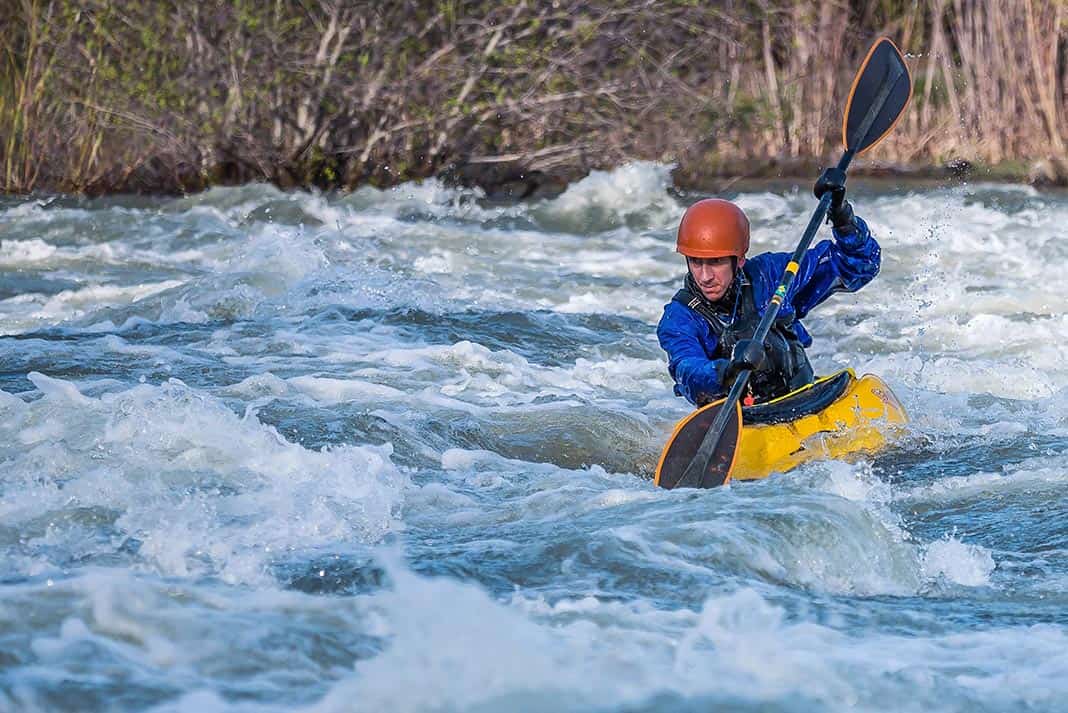
Shell layers are usually waterproof and have seams that are sealed at the factory to prevent leaks. The most versatile shell layers are made from breathable materials. These materials allow some perspiration to escape from the inside of the fabric. This helps keep you drier and more comfortable while paddling. Kayaking paddling jackets have specialized neck and wrist closures to help keep water out. Neoprene or similar cuffs seal sleeves and ankles more tightly than conventional closures. Even drier are the latex gaskets found in drysuits and drytops.
Sun protection for kayakers
The best way to avoid sunburn is to cover as much of your body as possible with sun blocking layers. The same base layers you wear under insulation in cool weather will effectively keep the sun at bay. Specialized sun blocking layers do an even better job and often come in cooling fabrics that will keep you comfortable in the heat. Add a wide-brimmed hat, sunglasses and a liberal application of sunscreen you’ll be ready for action. There are even sun gloves that offer protection for those who prefer not to lotion up.
Which shoes to wear for kayaking
Most kayakers favor wearing neoprene footwear and water shoes. Neoprene wetsuit booties keep your feet warm when wet. Waterproof neoprene boots keep water out and are even warmer. Both are low-profile to give you lots of wiggle room in your kayak.
Water shoes come in all varieties, from thin slip-ons to lace-up water boots. Shoes typically have more structure and support than neoprene booties and are a good choice if you know you’ll have to spend some time on your feet and want to take a shoreside ramble.
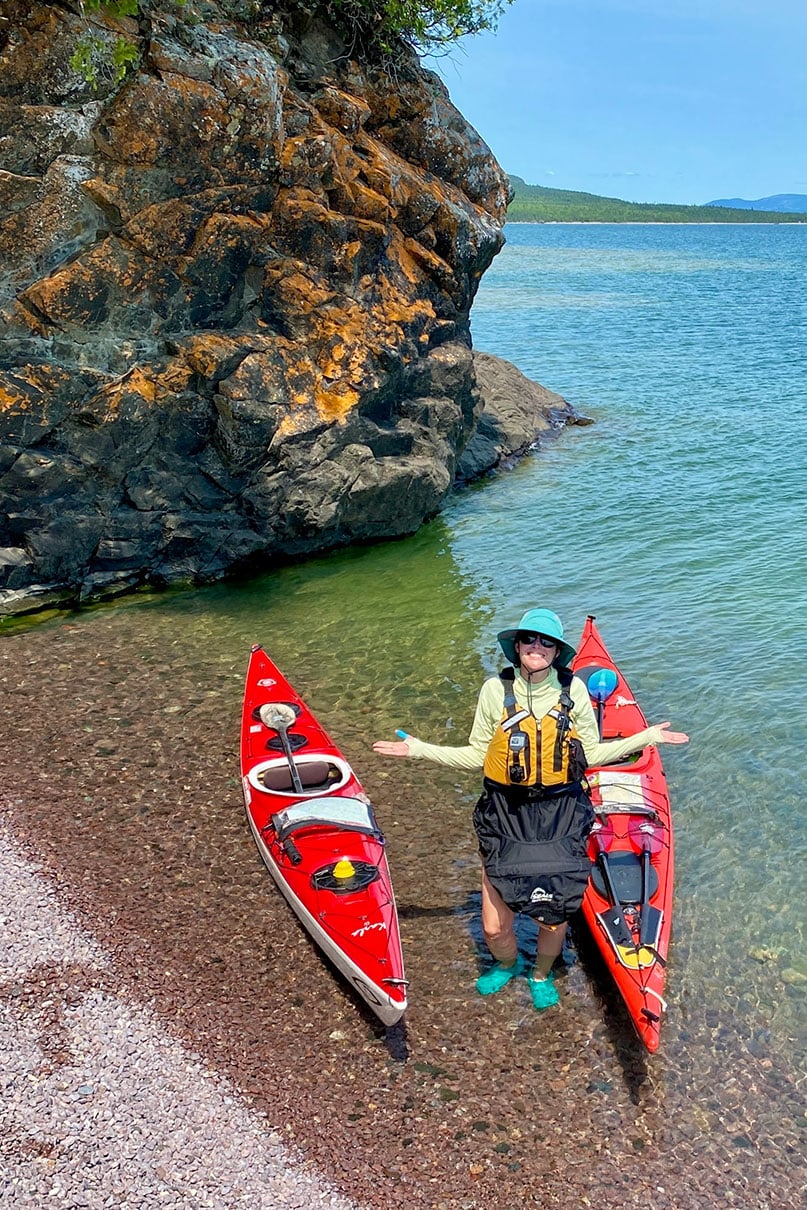
Sandals can be a good choice for many paddlers, however some people find them bulky and uncomfortable in an enclosed sit-inside kayak. But going barefoot is a bad idea. You never know what you might step on when you hop out of your kayak. It’s best to wear some kind of footwear for protection. A thin water shoe is better than nothing.
What to wear kayaking in summer
Dressing for kayaking in the summer can be either a breeze or a challenge, depending on the water temperature. Hot weather and warm water call for a focus on sun protection, but if the water is cold, you need to balance comfort in the cockpit with safety in the event of a swim.
In hot conditions with warm water, paddlers should focus on clothing that helps keep them cool and protected from the sun. Wicking base layers with long sleeves provide good coverage and sun protection. Specialized base layers are available with hoods and long sleeves for maximum coverage up top. Lightweight nylon shirts or hooded tops are another option for sun protection. Comfortable and quick-dry board shorts will do in many cases, but long, quick-dry nylon pants offer extra protection from sun and biting insects. A broad-brimmed hat is a good choice to keep the sun off your face and neck. Specialized paddling gloves are available to protect hands from sunburn.
If the water is below 70°F, dressing for summer is more challenging. If you go for a swim in shorts and a t-shirt in Lake Superior or coastal Maine, you’ll get hypothermic even if the air temperature is warm. Wetsuits provide enough insulation for a dip in these conditions, but wetsuits are hot to wear when air temperatures climb.
There are a couple of ways to work around these challenges.
What to wear under a drysuit and wetsuit in summer
If you’re wearing a wetsuit for insulation in summer you’ll want to maximize cooling while you’re in your kayak. Skip the shell layers so that any breeze will help cool your body. Wet yourself down from time to time to keep cool. Some kayakers will roll or dip their head into the water while holding onto a friend’s boat, or even go for a deliberate swim.
If you’re wearing a drysuit in summer, layer thin base layers underneath. You won’t have as much insulation, but you’ll have enough to protect you from all but the coldest water. If you start to overheat, use the techniques suggested above.
What shoes to wear kayaking in the summer
Water shoes are comfortable to wear in the summer, whether you’re paddling in shorts or a drysuit. They provide protection from sharp objects in the water and comfort in your kayak. Neoprene footwear is comfortable in the kayak but hot on summer days.
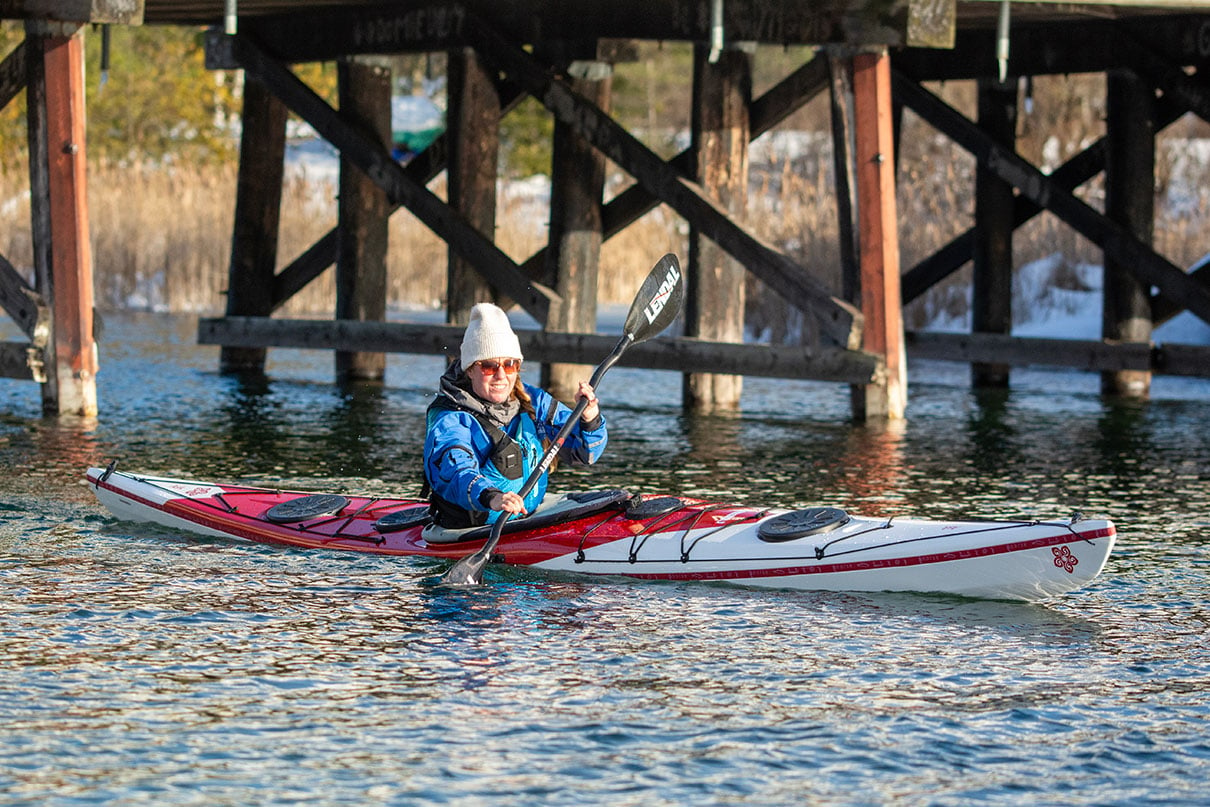
What to wear kayaking in colder temperatures
Anytime the water is cold, kayakers need to dress for cold water immersion. This means a wetsuit or drysuit and appropriate layers to account for conditions.
The colder the weather and water are, the more insulation you’ll need to stay warm. You can add fleece layers to your wetsuit, or use a thicker wetsuit, but eventually it becomes more practical to switch to a drysuit. Fleece layered under a drysuit will keep you much warmer than a wetsuit. When temperatures really dip, a drysuit is the way to go.
Cooler weather calls for different headgear and handwear. Warm, waterproof headwear is key to maintaining body heat. A hooded paddling jacket offers protection from wind and seals in more heat. Thick neoprene gloves are an option for protecting your hands but many paddlers find pogies to be warmer and more useful. Pogies are neoprene mittens that attach to your paddle. You can often keep your hands bare under pogies so you have a good feel for the paddle. Some paddlers wear thin gloves under pogies so they have a little protection when their hands are outside the mitts.
What shoes to wear kayaking in cold weather
Cooler water and cooler air call for warmer footwear. Neoprene booties are a good choice and can be worn over wool socks for extra warmth and comfort. Waterproof neoprene boots will keep your feet dry and are a better choice as temperatures fall. Water shoes can be made warmer by wearing them over neoprene socks.
Extra layers for kayaking in cold weather
If you’re relying on fleece for insulation in early fall, it’s a good idea to pack an extra set of clothes to change into in the event of a swim. Paddlers using wetsuits might pack an extra fleece top for insulation or an oversized hooded jacket to be worn over other layers. Multi-day trips call for clothing that can be dried on the body or extra layers that can be swapped out in camp. In cold weather, it isn’t a bad idea to take a simple beach shelter like a tarp for protection during breaks, and a thermos with a hot drink to help warm you up.
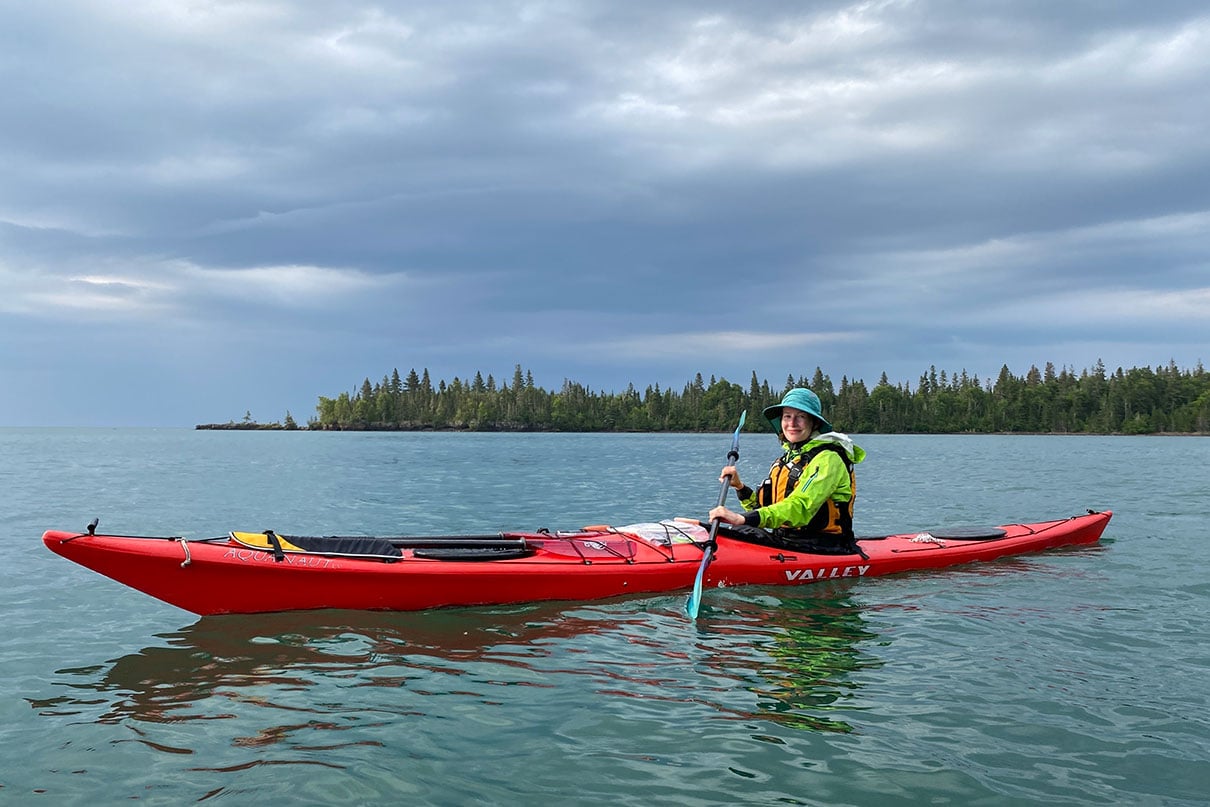
What to wear kayaking in the rain
Kayaking in the rain can be pleasant or downright miserable. The right clothing makes all the difference.
Closed-cockpit kayaks fitted with sprayskirts stay remarkably dry in the rain. Open sit-on-top designs are much more exposed to the elements. The right clothing for each will help you stay comfortable if it starts to pour when you are on the water.
In a closed-cockpit kayak, the most comfortable piece of clothing you can wear is a hooded paddling jacket that fits tightly over your sprayskirt. The skirt seals your lower body from the rain so you’ll stay dry and warm from the waist down. The paddling jacket keeps your upper body dry and comfortable.
If you’re paddling a sit-on-top design, you’ll need waterproof paddling pants as well as a jacket. In this case, it’s better to choose a jacket that is a little longer at the waist so your top overlaps your pants and prevents any gaps where water could trickle through. Paddling bib pants or waders are another good way to get extra protection from rain and spray, and they’ll keep your feet dry if you step into the water. Waterproof neoprene boots are a great choice for keeping your feet warm and dry in rainy weather.
Sea kayakers wearing drysuits have a couple options for rainy weather. A broad-brimmed waterproof hat will keep the water out of your eyes on a warm day. In colder weather, rain might call for adding a hooded waterproof jacket over the top of your drysuit and PFD.
A waterproof-breathable paddling jacket or drytop with hood keeps paddlers comfortable even on foul weather days. | Feature Photo: Virginia Marshall



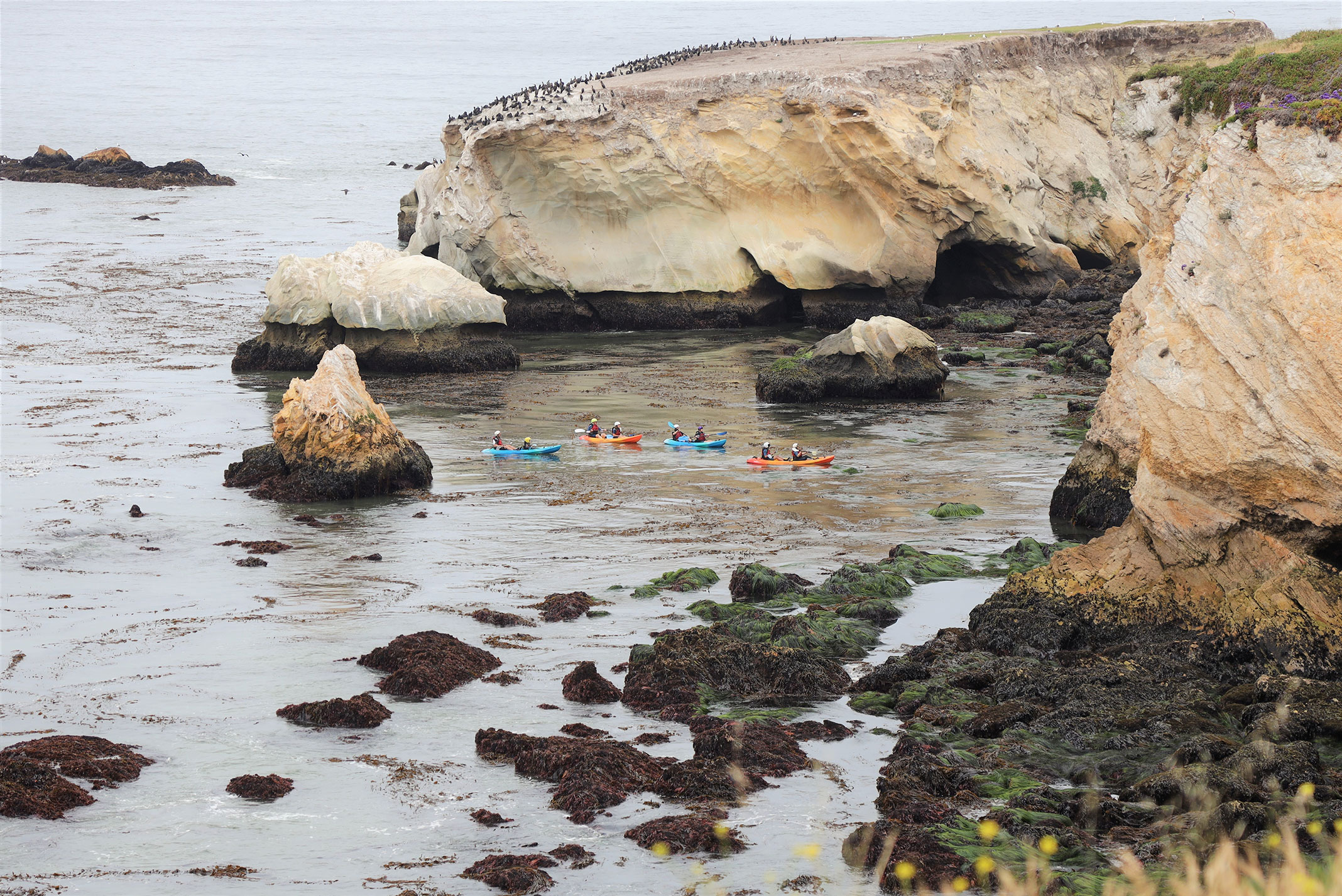
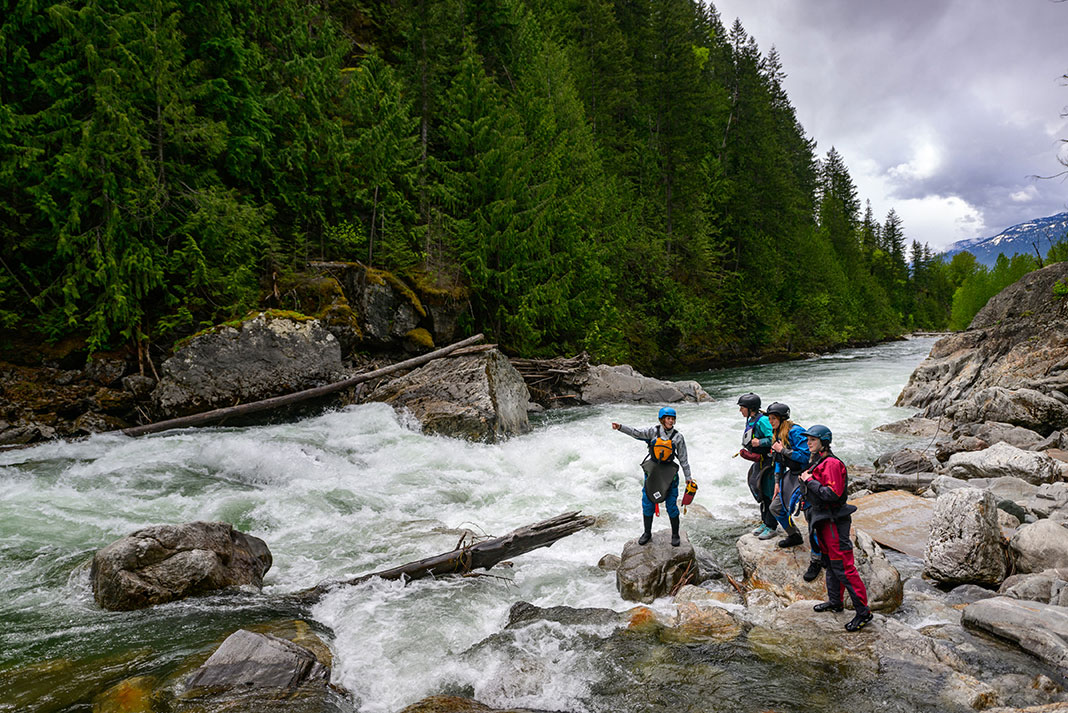

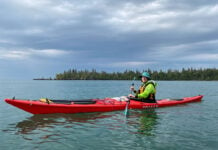



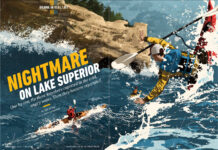

One comment about footwear: bigger feet on taller kayaks mean bigger boots in some cases. Depending upon the cockpit height of the traditional kayak, too thick of a heel can limit the room you have to properly position your feet (if the deck/cockpit height is too short). Sometimes wearing a bootie without raised heel is better. You can add a cushioning pad onto your deck hull floor where your heel rests for more comfort. Also,what’s your typical landing sites like? Soft sand or rocky shoreline….different soles (hard, soft, smooth, treaded) all make a difference in how securely and comfortably you can walk once ashore. Sometimes you need to bring an extra set of boots along, one for paddling, one for extensive shoreside walking. Be Smart, Be Safe, Have Fun!